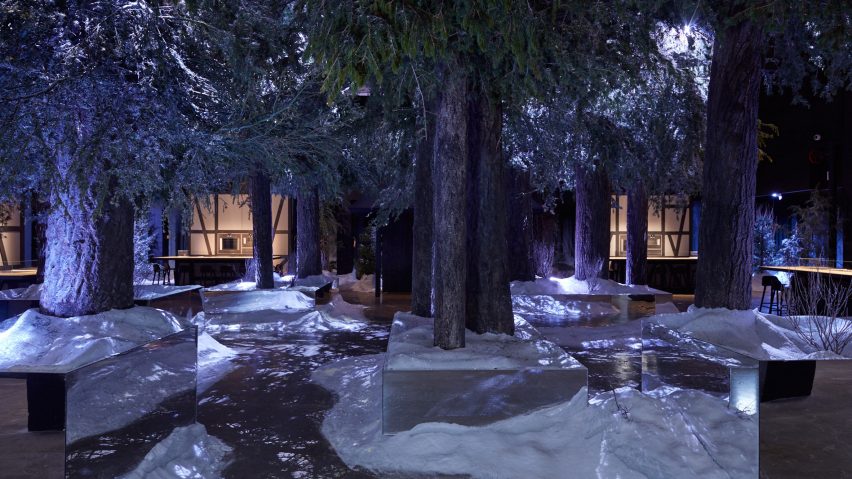A forest of trees, artificial snow and a giant cuckoo clock provided the setting for dinners at a pop-up restaurant in Los Angeles, created by German designer Hendrik Müller for kitchen brand Gaggenau.
Restaurant 1683 was installed on the 11th floor of a warehouse building in Downtown LA, and hosted dinners over three consecutive evenings last month, 21-23 May 2018.
Organised by Gaggenau to coincide with its 333rd anniversary, the temporary restaurant was run by three-Michelin-starred chef Daniel Humm of Eleven Madison Park, the NoMad New York and the recently opened NoMad Los Angeles.
To provide the setting for the dining experience, Müller and his team at Einszu33 look to the brand's roots as a nail forge in Germany's Black Forest – famous as the setting for the Brothers Grimm fairy tales and its cuckoo clocks.
"Our interpretation immediately brought up the idea of creating an immersive experience within a forest-setting, which would bring the mystic atmosphere of the Black Forest to life," Müller told Dezeen.
After entering the Cooper Building, guests ascended in a freight elevator to the 11th floor, where they were met by a huge cuckoo clock that formed a backdrop for event photos.
Around the edge of the central installation was an exhibition tracing Gaggenau's history – including early products, material developments and photographs.
A lounge area at the back made the most of the large industrial-style windows, which provided views over LA's Fashion and Arts Districts, and beyond, so guests could watch the sunset during cocktails and canapés.
Inside the installation was an entirely different scene. In the centre of the dark space stood groupings to 22-foot-tall (6.7-metre) trees, housed within mirrored planters and surrounded by artificial snow.
"The overall atmosphere we decided for was a snowy forest flooded with moonlight, which creates patterns of the branches on the floor of the dining space," said Müller, who comes from the Black Forest himself.
Diners were seated at six kitchen stations around the sides of the space, where they could watch the chefs prepare the food. Each was backed by panels designed to look like traditional timber-framed German houses.
A working metal forge was positioned between the trees, so the clanging of metal could be heard throughout the evenings.
To create such an elaborate setting for three days provided Müller with several challenges, he told Dezeen.
"The challenges we found were in logistics, timing and lighting," the designer said. "The venue was not easy to access since we had large building components to handle with a cargo lift with a limited space."
"Lighting was a challenge since the event started before sunset, and we had to consider the impact of daylight inside the inner dining space, and make sure it would not interfere with the atmosphere," he added.
The trees were fabricated by a team that typically works on Hollywood set designs. They were built as hollow plywood tubes supported inside by metal frames, with real fir branches attached to trunks cast using rubber moulds taken from real bark.
Many of the other parts of the installation were fabricated in Germany and shipped over to LA, then assembled on site.
From conception to election, the project took eight months to complete. Installation in the Cooper Building took five days, then a further three days were required for dismantling.
The idea for Restaurant 1683 was first realised in New York in 2016, when Gaggenau also worked with chef Humm on a series of invite-only dinners, but with different scenography.
The West Coast event also supported Operation Smile, a charity that helps children suffering from a cleft condition.

